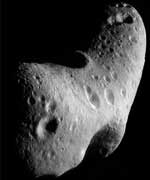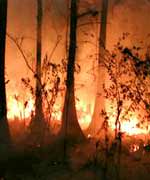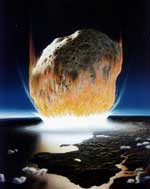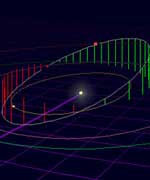Early Wednesday morning, a 5,500 million pound asteroid measuring 5 kilometers in length will pass very close to Earth.
An asteroid two to three times that diameter is credited with causing the extinction of 85 percent of the world’s species, including the dinosaurs, when it hit our planet 65 million years ago.
Luckily for us, asteroid Toutatis is only a tourist, and doesn’t plan to stop here. It will come within 1.5 million kilometers (960,000 miles) of Earth, or four times the Earth-moon distance. Toutatis is the largest asteroid to come that close in more than a century.
Many smaller asteroids often pass well inside the moon’s orbit. The Earth is also hit continually with tiny meteors that often become “shooting stars” as they harmlessly burn up in the atmosphere.
But if a rock the size of Toutatis hit, the atmosphere would do little more than slow it down a bit before it slammed to Earth. The impact would create a vast crater, and toss so much dust and vaporized minerals into the air the skies would darken. Seismic waves created by the explosion would generate tsunamis and earthquakes, and red-hot rocks falling back to Earth would ignite forest fires.
Toutatis, also known as asteroid 4179, is 4.6 kilometers (2.9 miles) long and 2.4 kilometers (1.5 miles) wide. Although Toutatis looks like a large peanut, radar images revealed it is actually composed of two rocks that are in close contact. One of the rocks is approximately twice as large as the other.
Toutatis has a strange rotation –instead of the spinning on a single axis, like the planets and most other asteroids do, Toutatis tumbles so erratically that its orientation with respect to the solar system never repeats.
“The vast majority of asteroids, and all the planets, spin about a single axis, like a football thrown in a perfect spiral,” says Scott Hudson of Washington State University, “but Toutatis tumbles like a flubbed pass.”
Toutatis’s four-year orbit around the sun is also eccentric, extending from just inside the Earth’s orbit to the main asteroid belt between Mars and Jupiter.
Astronomer Christian Pollas discovered Toutatis on January 4, 1989. Pollas spotted the asteroid on photographic plates taken by Alain Maury and Derral Mulholland, who had taken the photos while observing Jupiter’s satellites.
Toutatis flew close by Earth in 1992 and 1996, but it hasn’t come this near to us since 1353. The next time it will pass this close again will be in the year 2562. The asteroid’s orbit around the sun is so eccentric that it can’t be predicted with much certainty for more than a few hundred years in the future. Since researchers can’t say Toutatis will never hit Earth, it is currently listed as a Potentially Hazardous Asteroid.
There is a rumor circulating on the Internet that the asteroid will strike Earth during this 2004 flyby. However, astronomers have been tracking the path of Toutatis ever since it was discovered, and they are certain it will pass safely by Earth.
Throughout history, several asteroids have hit Earth. The solar system was cluttered with asteroids while the Earth was young, and the face of the moon and other dead planetary bodies shows how frequent such impacts were. Impacts by large rocks are much less frequent today, but they can still occur.
There are thought to be more than 300,000 nearby small asteroids (asteroids about 100 meters across). Such asteroids should statistically hit Earth once every few thousand years. The most recent such asteroid strike occurred in 1908, when an asteroid measuring about 60 meters in diameter hit Russia. The “Tunguska” bolide exploded in the atmosphere and flattened about 700 square miles of Siberian forest.
Large (1 kilometer or greater) asteroids are far more rare and infrequent. There are only about 1,100 nearby large asteroids, and they are predicted to strike the Earth every half million years or so. But when these asteroids strike, they can cause catastrophic changes in the global climate. Asteroids that cause mass extinctions are thought to be 10 kilometers or greater in diameter.
The Spaceguard Survey was established to track large asteroids and comets that might pose a direct threat to Earth. So far, the Spaceguard Survey has found about half of these NEOs, and they expect to find the majority of them by 2008.
Although Toutatis will be in the far southern sky when it is closest to Earth, the asteroid is expected to brighten a few days prior to a 10th magnitude point of light visible from the Northern Hemisphere. Sky-watchers should look for it near the bright star Delta Capricorni.
Toutatis won’t be visible to the naked eye, but binoculars should suffice for spotting it in the night sky. A telescope would provide the best viewing, because it would allow the viewer to detect the slow motion of Toutatis against the background stars.
Original Source: Astrobiology Magazine Article




